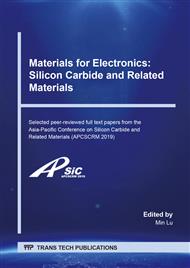p.8
p.14
p.22
p.27
p.33
p.38
p.43
p.55
p.62
The Influence of Tri-Defects of Epitaxial Layers on the Performance of 4H-Sic Diodes
Abstract:
The triangular defect is a common defect in the 4H-SiC epitaxy, which is also one of the killer defects to the 4H-SiC devices. In this paper, the 4H-SiC epitaxial wafer was grown by chemical vapor deposition (CVD). The formation mechanism of triangular defects in silicon carbide epitaxy was analyzed, and the solutions were proposed. Then, the diodes were fabricated on the wafer, and the influence of triangular defects on the forward and reverse I-V characteristics of 4H-SiC diodes was analyzed by tracking the defects map. The results show that the presence of triangular defects can lead to the reduction of the reverse voltage by about 40%, an increase of the leakage current by four orders of magnitude, and an increase of the forward conduction resistance.
Info:
Periodical:
Pages:
33-37
Citation:
Online since:
November 2020
Authors:
Keywords:
Price:
Сopyright:
© 2020 Trans Tech Publications Ltd. All Rights Reserved
Share:
Citation:


